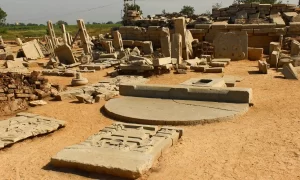Published on: December 30, 2021
SANNATI
SANNATI
NEWS
Efforts are on to include the Buddhist site excavated in and around Sannati, on the banks of the Bhima in Chittapur taluk of Kalaburagi district, in the World Heritage site list of UNESCO
- Small village, located on the banks of the Bhima River in Chitapur taluk of Kalaburagi district of Northern Karnataka.
- In 1986, when the roof of the Kali temple in Chandralamba temple complex collapsed, it destroyed the idol. However it revealed four Ashokan edicts on the floor and foundation stone of the temple.
- These edicts were written in a Prakrit language and Brahmi script and one of them was used as foundation of the pedestal for the Kali idol
- During subsequent excavations by Archaeological Survey of India (ASI) and the State Archaeology Department, tablets, sculptures, and other terracotta items were found
- Numerous limestone panels of sculptures of the ruined ‘Maha Stupa’ or Adholoka Maha Chaitya (the Great Stupa of the Netherworld) were found.
- Archaeologists believe that Ranamandal was a fortified area, spread over 86 hectares (210 acres; 0.33 sq mi), out of which only 2 acres had been excavated by 2009.
- Clay pendants, black polished pottery, Satavahana and pre-Satavahana coins, ornaments made of copper, ivory and iron, a township with paved pathways, houses, and limestone flooring have been found.
- Many excavated items were later shifted to Gulbarga Museum.
- The government has asked the Archaeological Survey of India to take up further exploration of the Ranamandal area to know the history of the region and its connection with Buddhism.
- One of the stones – the only known example of its type – is of Emperor Asoka (r. 274–232 BC) seated on his throne. It is probably the only surviving image of the emperor
- Apart from portions of major rock edicts, the special rock edicts I and II available in Dhauli are also found in Sannati.
- Because of the elaborate fortification, the site of Sannati is identified with Suvarnagri, one of the four provincial capitals of the Mauryan empire.
MAHITI FOR PRELIMS
WORLD HERITAGE SITES
- A World Heritage Site is a place that is listed by UNESCO for its special cultural or physical significance. The list of World Heritage Sites is maintained by the international ‘World Heritage Programme’, administered by the UNESCO World Heritage Committee.
- The United Nations Educational, Scientific and Cultural Organization (UNESCO) seeks to encourage the identification, protection and preservation of cultural and natural heritage around the world considered to be of outstanding value to humanity.
- This is embodied in an international treaty called the Convention concerning the Protection of the World Cultural and Natural Heritage, adopted by UNESCO in 1972.
- India has 38 world heritage sites that include 30 Cultural properties, 7 Natural properties and 1 mixed site.


